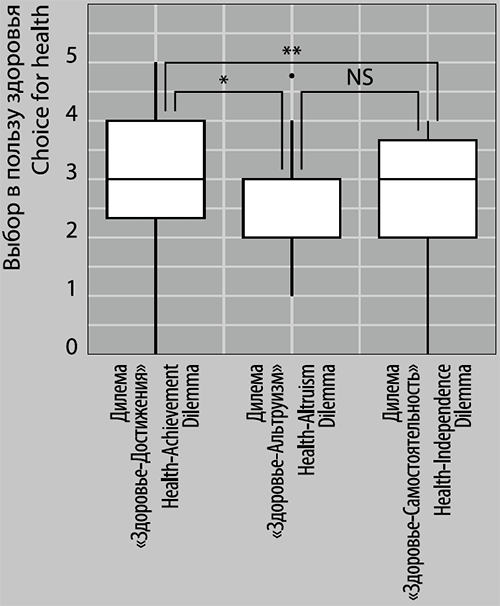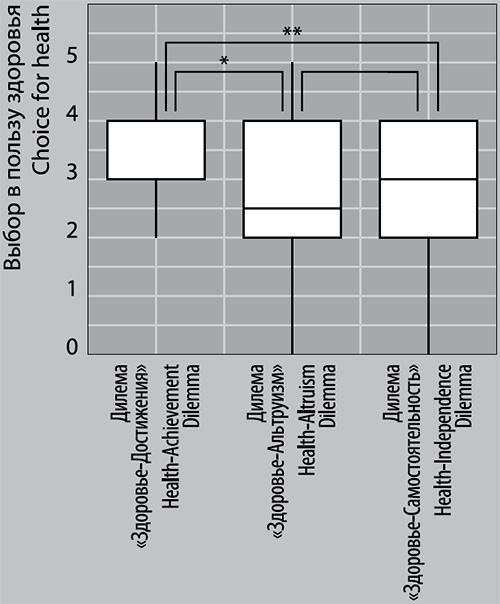Article
Arina G.A., Iosifyan M.A., Nikolaeva V.V. (2018). Explicit and implicit values are associated with decisionmaking in dilemmas related to health. National Psychological Journal, 4, 77–85.
Abstract
Background. Individuals who aim at changing their health behaviour do not always handle the issue immediately. This discrepancy is usually referred to as the intention behaviour gap. Implicit processes are one of the factors which mediate between intention and behaviour. Compared to cognitive and affective implicit processes, motivational implicit processes are given a very little account in the modern science. Currently it is not quite clear how implicit and explicit values are focused on within the health-related decision-making process.
Objective. The present study shows how implicit and explicit values and their congruency are focused on health-related decision-making process in dilemmas. The dilemmas were described as situations within which the subjects report on making a choice: either to avoid losses related to health, or to avoid losses related to other values. Choosing health, the participant avoids losses related to it, whereas they acquire losses related to other values, and vice versa.
Design. The participants participated in the Schwartz’s Value Survey (measuring explicit values), Implicit Association Tests (measuring implicit values) and solve three types of dilemmas (health vs benevolence, health vs self-direction, health vs achievement).
Research Results. The research shows that implicit and explicit values are not related to each other and are differently related to decision-making process in dilemmas. Namely, implicit values of achievement, benevolence and self-direction are related to decision-making in dilemmas with low potential losses. Many of these values turn to be significant to the participants, and some of the dilemmas are not solved in favour of health-related issues. Explicit values are related to decision-making process in dilemmas with high potential losses. Many of these values turn to be significant to the participants, and some of the dilemmas are not solved in favour of health-related issues. Finally, it was found that high correlation between explicit and implicit values is positively related to decision making in favor of health.
Conclusion. The research shows that explicit and implicit values are differently associated with health-related decision-making in the participants.
Accepted: 10/28/2018
Pages: 77-85
DOI: 10.11621/npj.2018.0407
PDF: Download
Keywords: motivation; values; implicit processes; health; decision-making;
Available Online 30.01.2019

Fig 1а. High loss dilemmas (median and standard error are).* Z = -2.821, p = .005; ** Z = -2.578, p = .010; NS difference is insignificant.

Fig 1b. Low loss dilemmas (median and standard error are).* Z = -3.007, p = .003; ** Z = -3.570, p = .000; NS difference is insignificant.
Table 1. Regression model for solutions to low loss dilemmas
|
Variable |
Estimate |
SE |
df |
t-value |
p-value |
|
Sex and Age |
|||||
|
Sex |
0.237 |
0.29 |
49.29 |
0.802 |
0.426 |
|
Age |
0.013 |
0.15 |
46.20 |
0.087 |
0.931 |
|
Implicit Values |
|||||
|
Health |
0.129 |
0.39 |
27.77 |
0.335 |
0.740 |
|
Other Values |
-0.731 |
0.34 |
50.99 |
-2.160 |
0.035 |
|
Explicit values |
|||||
|
Safety |
-0.222 |
0.21 |
15.13 |
-1.070 |
0.301 |
|
Other Values |
-0.096 |
0.13 |
118.82 |
-0.738 |
0.462 |
|
Consistency of explicit and implicit values |
|||||
|
Consistency |
0.799 |
0.24 |
41.04 |
3.305 |
0.002 |
NB. Estimate – standard error; SE – standard deviation; df – degree of freedom.
Table 2. Regression model for solutions to high loss dilemmas
|
Variable |
Estimate |
SE |
df |
t-value |
p-value |
|
Sex and Age |
|||||
|
Sex |
0.005 |
0.258 |
50.62 |
0.021 |
0.984 |
|
Age |
-0.042 |
0.133 |
46.95 |
-0.319 |
0.751 |
|
Implicit Values |
|||||
|
Health |
0.141 |
0.365 |
23.51 |
0.387 |
0.703 |
|
Other Values |
-0.209 |
0.283 |
62.53 |
-0.739 |
0.463 |
|
Explicit values |
|||||
|
Safety |
-0.176 |
0.180 |
45.84 |
-0.975 |
0.335 |
|
Other Values |
-0.247 |
0.109 |
114.31 |
-2.260 |
0.023 |
|
Consistency of explicit and implicit values |
|||||
|
Consistency |
0.551 |
0.214 |
34.96 |
2.571 |
0.015 |
NB. Estimate – standard error; SE – standard deviation; df – degree of freedom.
References:
Ajzen I. (1991). The theory of planned behavior. Organizational Behavior and Human Decision Processes, 50(2), 179–211. doi: 10.1016/0749-5978(91)90020-T
Ananiev V.A. (1998). Introduction to Health Psychology: Study Guide. SPb, SPbMAPO.
Bailey R., & Wells A. (2013). Does Metacognition Make a Unique Contribution to Health Anxiety When Controlling for Neuroticism, Illness Cognition, and Somatosensory Amplification? Journal of Cognitive Psychotherapy, 27(4), 327–337. doi: 10.1891/0889-8391.27.4.327
Bardi A., & Schwartz S. H. (2003). Values and Behavior: Strength and Structure of Relations. Personality and Social Psychology Bulletin, 29(10), 1207–1220. doi: 10.1177/0146167203254602
Baumann N., Kaschel R., & Kuhl J. (2005). Striving for unwanted goals: stress-dependent discrepancies between explicit and implicit achievement motives reduce subjective well-being and increase psychosomatic symptoms. Journal of Personality and Social Psychology, 89(5), 781–799. doi: 10.1037/0022- 3514.89.5.781
Becker, M. H. (1974) The Health belief model and personal health behavior. C. B., Slack.
Cieciuch J., Davidov E., & Algesheimer R. (2015). Development of value priorities in childhood: A longitudinal study. Social Development, 25(3), 503–527. doi: 10.1111/sode.12147
Fisher E. B., Fitzgibbon M. L., Glasgow R. E., Haire-Joshu D., Hayman L. L., Kaplan R. M., … & Ockene J. K. (2011). Behavior matters American Journal of Preventive Medicine, 40(5), 15–30. doi: 10.1016/j.amepre.2010.12.031
Gilbert D., & Waltz J. (2010). Mindfulness and Health Behaviors. Mindfulness, 1(4), 227–234. doi: 10.1007/s12671-010-0032-3
Greenwald A. G., McGhee D. E., & Schwartz J. L. (1998). Measuring individual differences in implicit cognition: the implicit association test. Journal of Personality and Social Psycholog, 74(6), 1464–1480. doi: 10.1037/0022-3514.74.6.1464
Greenwald A. G., Nosek B. A., Banaji M. R. (2003). Understanding and using the implicit association test: I. An improved scoring algorithm. Journal of Personality and Social Psychology, 85(2), 197–216. doi: 10.1037/0022-3514.85.2.197
Hilgard E. R. (1980). The trilogy of the mind: Cognition, affection, and conation. Journal of the History of Behavioral Sciences, 16, 107–117. doi: 0.1002/1520-6696(198004)16:2<107::AID-JHBS2300160202>3.0.CO;2-Y
Khaw K.-T., Wareham N., Bingham S., Welch A., Luben R., & Day N. (2008). Combined Impact of Health Behaviours and Mortality in Men and Women: The EPIC-Norfolk Prospective Population Study. PLOS Medicine, 5(1). doi: 10.1371/journal.pmed.0050012
Köllner M.G., & Schultheiss O.C. (2014). Meta-analytic evidence of low convergence between implicit and explicit measures of the needs for achievement, affiliation, and power. Frontiers in Psychology, 5. doi: 10.3389/fpsyg.2014.00826
Maio G. (2016), The Psychology of Human Value. NY, Psychology Press. doi: 10.4324/9781315622545
Martin K.A., & Leary M.R. (2001). Self-presentational determinants of health risk behavior among college freshmen. Psychology and Health. 16, 17–27. doi: 10.1080/08870440108405487
Matarazzo J. (1984). Behavioural immunogens and pathogens in health and illness. Psychology and health, 3, 9–43. doi: 10.1037/10082-001
McClelland D. C. (1985). Human motivation. Glenview, Ill., Scott, Foresman & Co.
Nikiforov G.S. (2006). Health psychology. SPb., Piter.
Papies E., Stroebe W., & Aarts H. (2007). Pleasure in the mind: Restrained eating and spontaneous hedonic thoughts about food. Journal of Experimental Social Psychology, 43(5), 810–817. doi: 10.1016/j.jesp.2006.08.001
Rasskazova E.I., & Ivanova T.Yu. (2015). Motivational models of health-related behavior: the problem of the «gap» between intention and action. [Psikhologiya: Zhurnal Vysshey Shkoly Ekonomiki], 12(1), 105–130.
Rogers R. W. (1983). Cognitive and physiological processes in fear appeals and attitude change: A revised theory of protection motivation. In Social Psychophysiology: A Sourcebook. New York, Guilford.
Rokeach M. (1973). The nature of human values. NY, Free Press.
Rosenstock I. M. (1974). Historical Origins of the Health Belief Model. Health Education & Behavior, 2(4), 328–335.
Schwartz S. H. (2009). Draft Users manual: proper use of the Schwarz Value Survey, version 14. Compiled by Romie F Littrell. Auckland, New Zealan, Centre for Cross Cultural Comparisons.
Schwartz S. H. (1994). Are There Universal Aspects in the Structure and Contents of Human Values? Journal of Social Issues, 50(4), 19–45. doi: 10.1111/ j.1540-4560.1994.tb01196.x
Sheeran P. (2002). Intention—Behavior Relations: A Conceptual and Empirical Review. European Review of Social Psychology, 12(1), 1–36. doi: 10.1080/14792772143000003
Sheeran P. (2011). More gym: The impact of priming endurance. Unpublished raw data. University of Sheffield, Sheffield, United Kingdom.
Sheeran P., Bosch J. A., Crombez G., Hall P. A., Harris J. L., Papies E. K., & Wiers R. W. (2016). Implicit processes in health psychology: Diversity and promise. Health Psychology, 35(8), 761–766. doi: 10.1037/hea0000409
Sheeran P., Harris P. R., & Epton T. (2014). Does heightening risk appraisals change people’s intentions and behavior? A meta-analysis of experimental studies. Psychological Bulletin, 140(2), 511–543. doi: 10.1037/a0033065
Smith C. P. (1992). Motivation and personality: Handbook of thematic content analysis. New York: Cambridge University Press. Crossref, Google Scholar. doi: 10.1017/CBO9780511527937
Smith M. S., & Wallston K. A. (1992). How to measure the value of health. Health Education Research, 7(1), 129–135. doi: 10.1093/her/7.1.129
Spangler W. D. (1992). Validity of questionnaire and TAT measures of need for achievement: Two meta-analyses. Psychological Bulletin, 112(1),140–154. doi: 10.1037/0033-2909.112.1.140
Strack F., & Deutsch R. (2004). Reflective and impulsive determinants of social behavior. Personality and Social Psychology Review, 8(3), 220–247. doi: 10.1207/s15327957pspr0803_1
Waldron J.J., & Krane V. (2005). Whatever it Takes: Health Compromising Behaviors in Female Athletes. Quest, 57(3), 315–329. doi: 10.1080/00336297.2005.10491860
Wallston K. A., Maides S., & Wallston B. S. (1976). Health-related information seeking as a function of health-related locus of control and health value. Journal of Research in Personality, 10(2), 215–222. doi: 10.1016/0092-6566(76)90074-XFor citing this article:
Arina G.A., Iosifyan M.A., Nikolaeva V.V. (2018). Explicit and implicit values are associated with decisionmaking in dilemmas related to health. National Psychological Journal, 4, 77–85.


